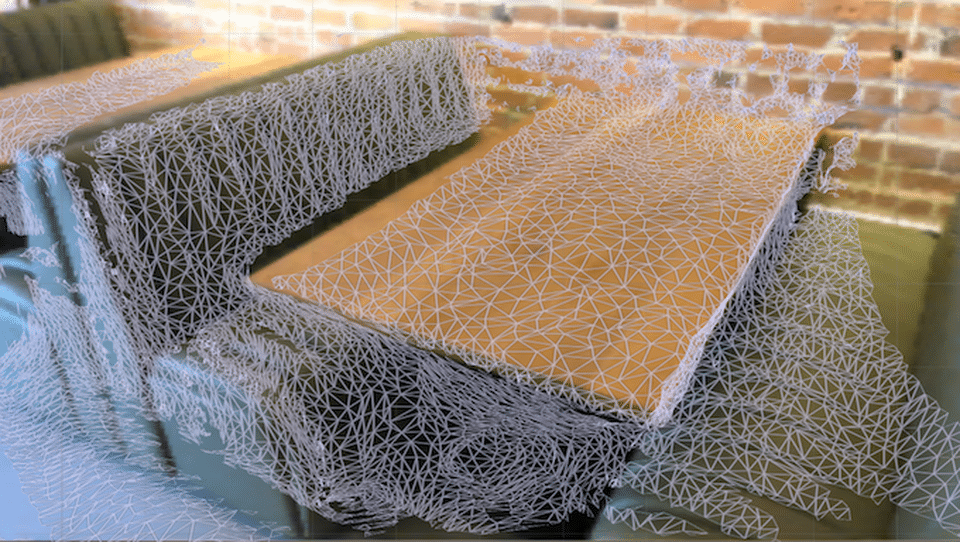
ARtillry Interviews is an ongoing series that profiles the biggest innovators in XR. Narratives are based on interviews with subjects but opinions and analysis are that of ARtillry. See the rest of the series here and our video interview show here.
In our ongoing coverage of the AR Cloud and its importance, one question keeps popping up: who will build it? The answer is that no one entity will do so (and there won’t just be one “cloud”), but several specialized toolsets will contribute to the AR Cloud’s assembly and maintenance.
One of those toolsets is 6D.ai. Bringing pedigree, validation and top IP to the table, it’s a front runner for potential impact and value creation among AR cloud startups. Its advantage also includes the perspective and AR tenure of co-founder & CEO Matt Miesnieks.
“The high-level objective is to make AR apps engaging beyond novelty,” he told ARtillry. “Among all the challenges, the one that personally appealed to me was the computer vision (CV) pieces that need to be built. And then how are those exposed to developers?”
The result is 6D.ai, which packages novel CV and scene mapping technology into an API. By handing that over to developers, it scales up the ability to build a spatial map of the world. In other words, users of 6D-powered apps can actively or passively map the world while experiencing AR.
“You start to get a data network effect where every app that uses a 6D powered app in a physical space contributes to making the description of that physical space more comprehensive,” said Miesnieks, “which means that the next person that comes along gets a rock-solid experience.”

AR’s Must-Haves
Starting in AR about a decade ago — a lifetime in XR years — Miesnieks gained early perspective on AR’s opportunity and challenges at AR pioneer Layar. That was reinforced at Dekko and then Samsung, during which he faced some of AR’s stickiest technical challenges.
These include image persistence, occlusion, physics-based graphical interactions, and semantic scene understanding (knowing that a couch is a couch). These challenges compel the AR cloud: a shared database to deliver scene geometry and enabling-data to far-flung AR devices.
“What occurred to me as an entrepreneur is that these are must haves, not nice to haves that make AR apps a bit better,” said Miesnieks. “If you assume that persistence and multiplayer are fundamental for AR, you need some sort of computer vision cloud infrastructure to support that.”
Next came a breakthrough for Miesnieks when meeting and seeing the IP of Oxford’s Active Vision Lab professor (now 6D’s chief scientist) Victor Prisacarui. His algorithm presented ways to solve some of AR’s vexing and longstanding issues. He just needed help bringing it to market.
“What Victor had was the ability to build a high resolution model of the world in real time on commodity mobile hardware,” said Miesnieks. “We figured out how to do it with a regular monocular RGB camera that is built into every smart phone today.”

Strength In Numbers
What made Prisacarui’s IP particularly compelling was the “real time” part. Building real-time spatial maps meant for the first time that AR apps could gain more sophisticated spatial awareness and semantic understanding on the spot, without advanced optics.
“With Victor’s technology, we had a way to tell an app developer, ‘you can now presume there’s a 3D model of the space, because if there isn’t one there, we’ll be able to build it for you in real time in the background, and it will be built as the app runs’,” said Miesnieks.
This also addressed a fundamental chicken & egg dilemma. The AR cloud wasn’t going to get populated without apps that could ingest scene mapping data at scale. And no one was going to use such apps if there’s no scene mapping data to create worthwhile AR experiences.
“No one was going to manually go out and capture that data in the way that Google Street View cars capture street data,” said Miesnieks. “They weren’t going to do it unless there was some application or use case to incentivize that behavior.”
This value exchange is core to 6D’s go-to-market strategy. By benefiting from AR cloud data, users are motivated to collect data. Further incentive can lie in game perks or performance. Think of it like Foursquare leader boards or, better yet, Waze’s incentivized data collection.
“There’s a way to build-in intrinsic rewards,” said Miesnieks. “There are status boards and leader boards, and maybe you unlock extra levels or capabilities into an app. That sort of thing can be very powerful to get people to go and scan places they might not otherwise have gone.”

Open For Business
As for 6D’s positioning and business objectives, it’s currently parlaying technical and IP chops with a fair dose of market validation and interest. But the company isn’t without challenges, including the current tech privacy environment that scrutinizes data tracking of any kind.
Miesnieks is confident in 6D’s data security, given that image data is processed on device. Then mathematical point descriptors are shared with the cloud, which can’t be reverse engineered (based on any research available today) to reveal anything of consequence or personal meaning.
Data security concerns could even work in 6D’s favor: Phone manufacturers, app publishers, and other potential partners prefer independent companies (read: not Google & Facebook). In other words, 6D’s interests are aligned with end users, as opposed to something like ad monetization.
“If we were to say that we’re going to sell ads on the back of this, the Disneys of the world wouldn’t want to work with us,” said Miesnieks. “They definitely don’t want to give that data to Google and Facebook. That’s turning out to be a driver of interest from these big players.”
And the interest level is rising. Word continues to spread to the broader tech and media worlds about the value creation that the AR cloud will bring. And that message is often coupled with whispers of groundbreaking IP, developing in San Francisco and University of Oxford.
“Where we’re going right now is turning the IP into shippable product,” said Miesnieks, “and just trying to chew through the backlog of demand.”
For deeper XR data and intelligence, join ARtillry PRO and subscribe to the free ARtillry Weekly newsletter.
Disclosure: ARtillry has no financial stake in the companies mentioned in this post, nor received payment for its production. Disclosure and ethics policy can be seen here.
Header image credit: Google
